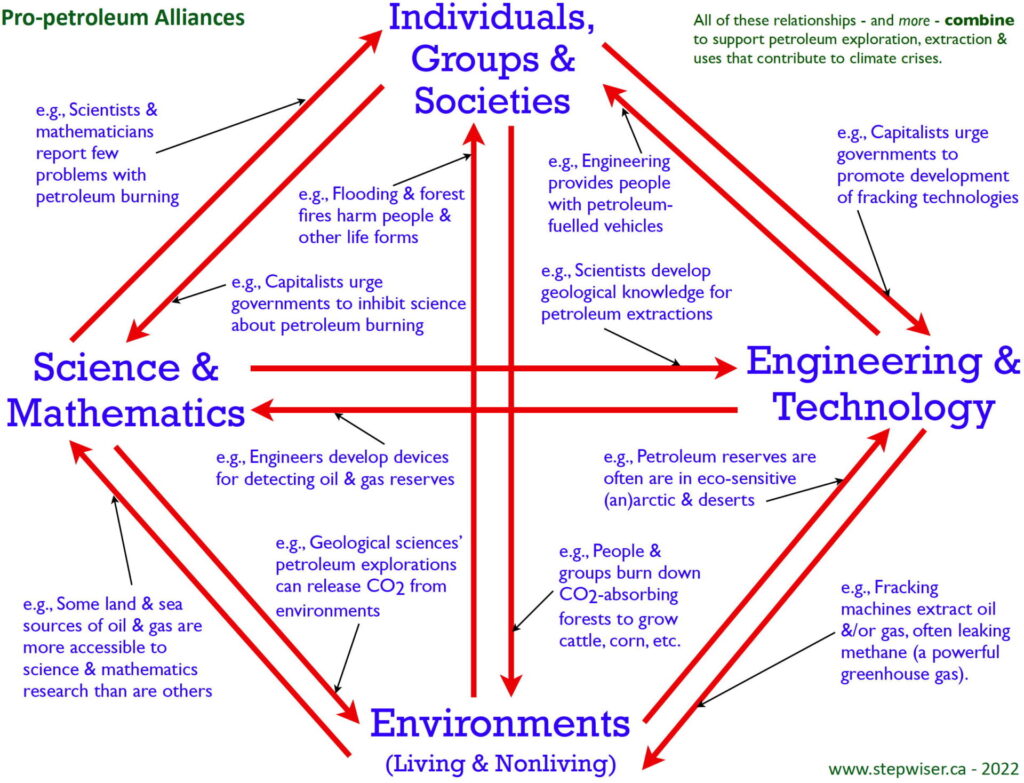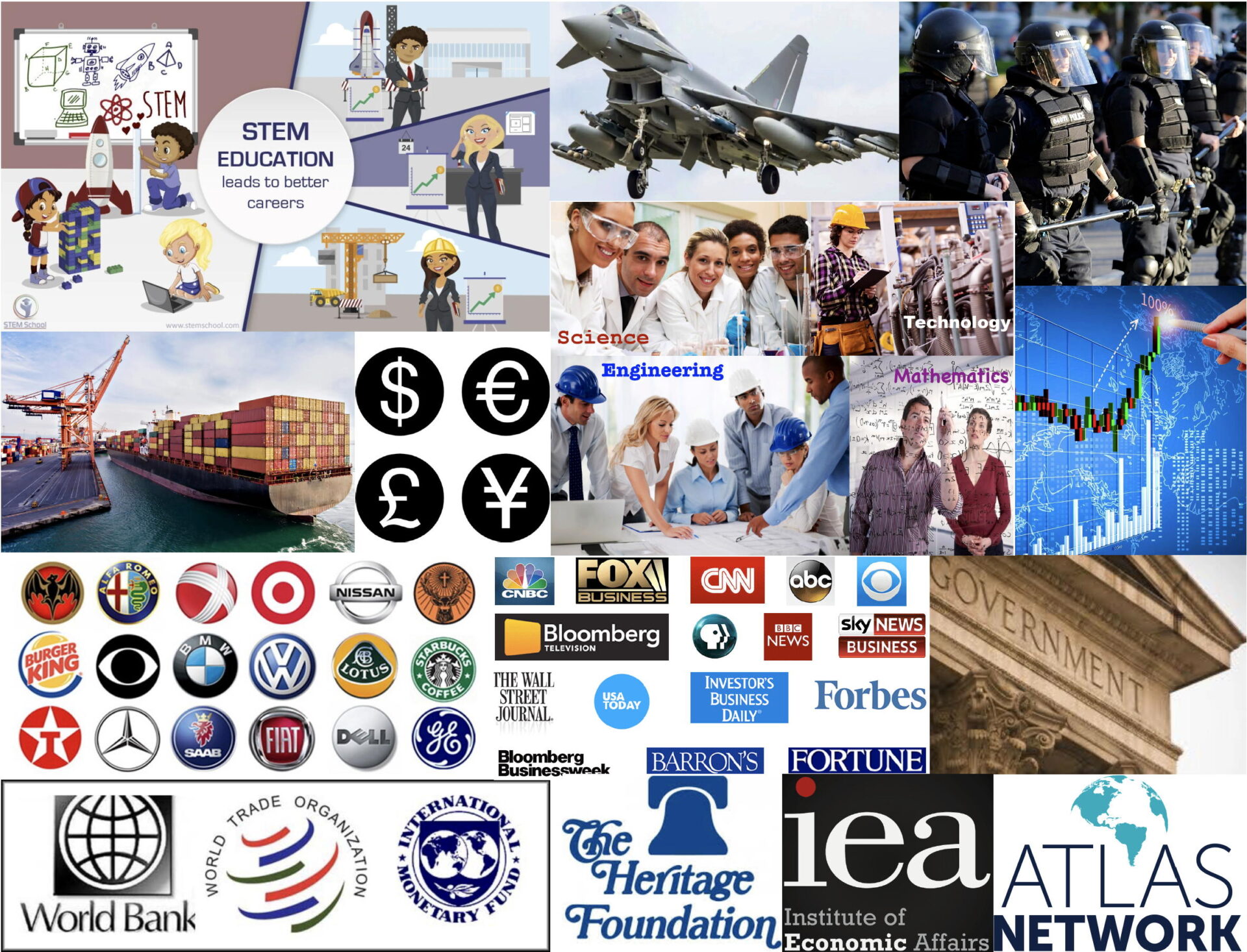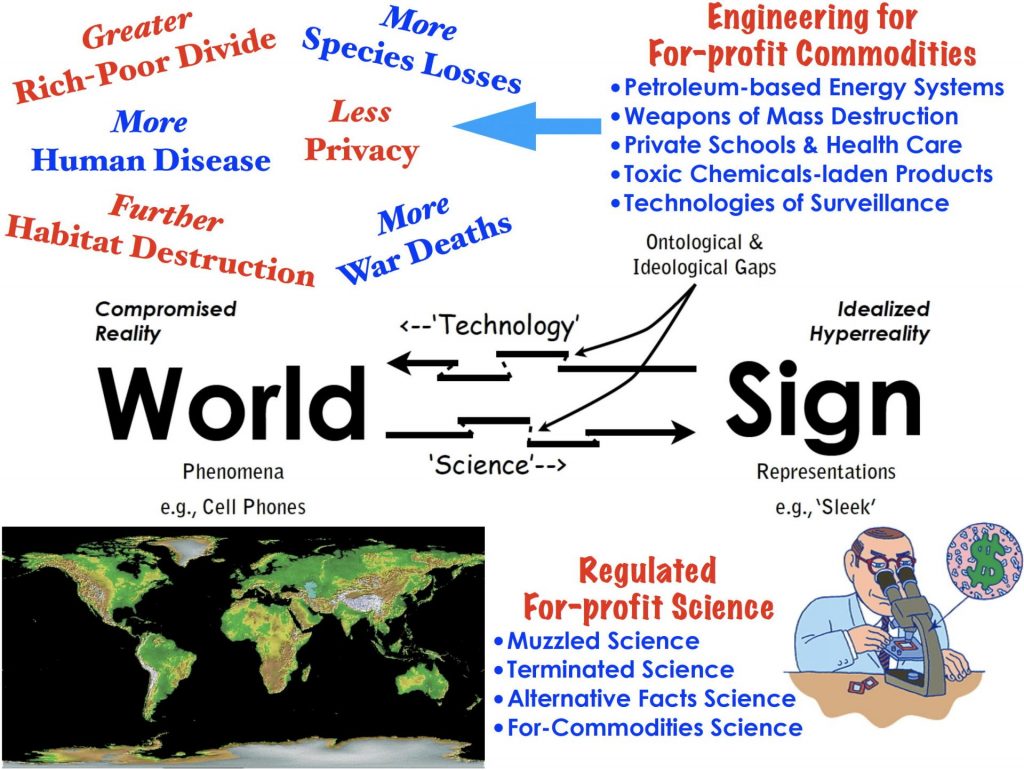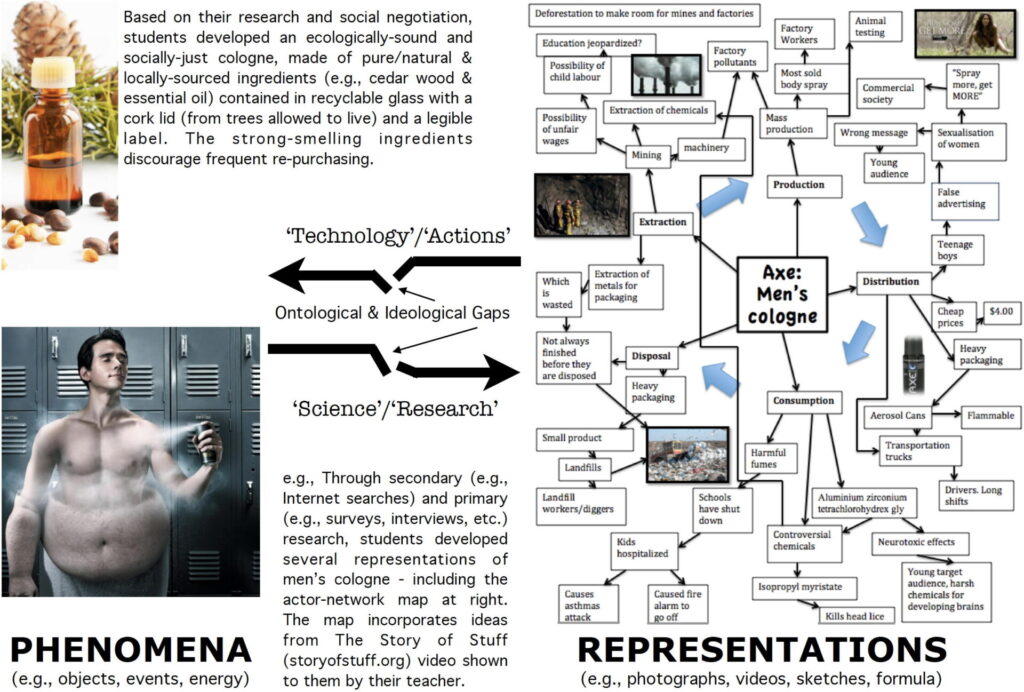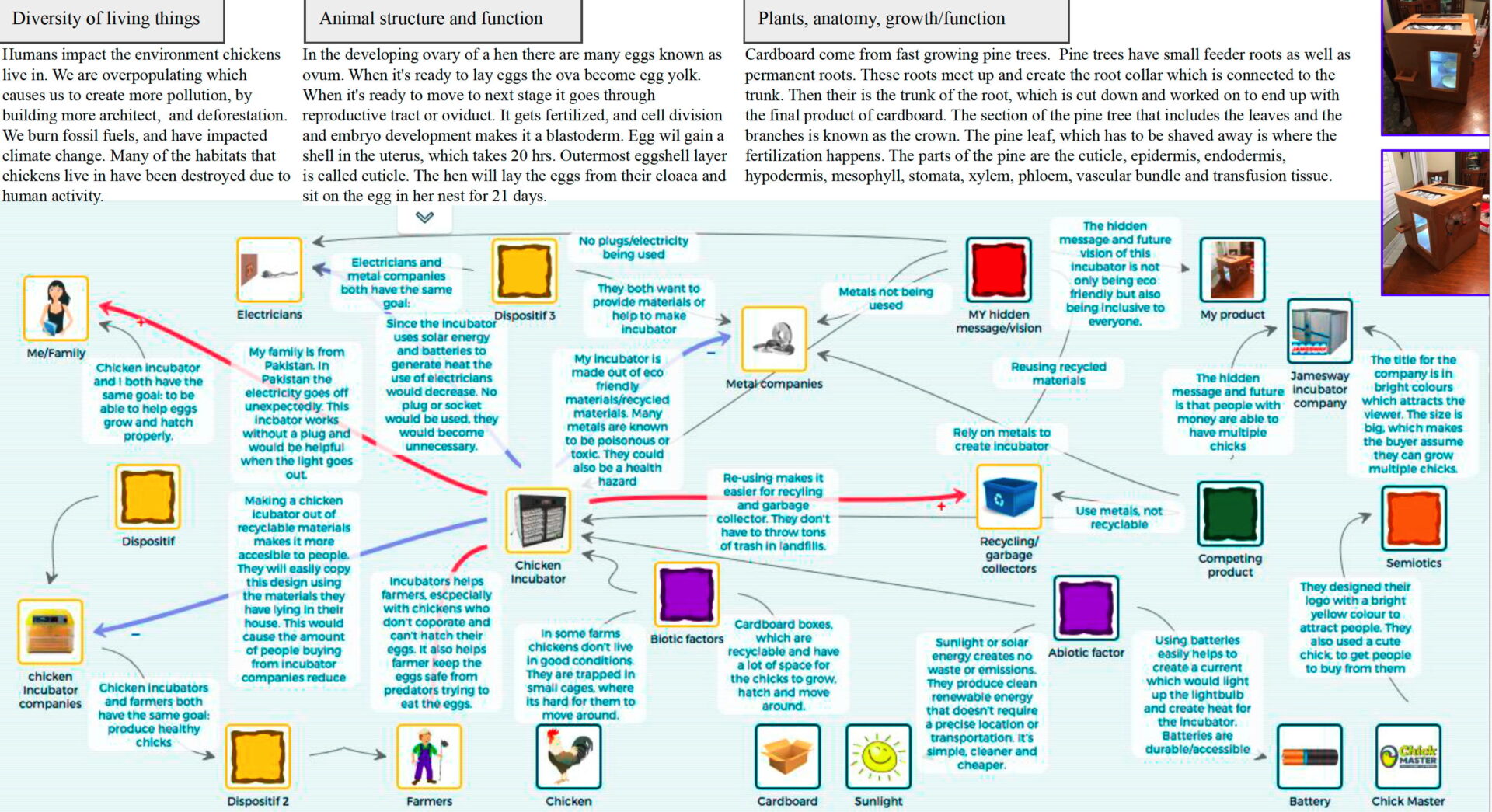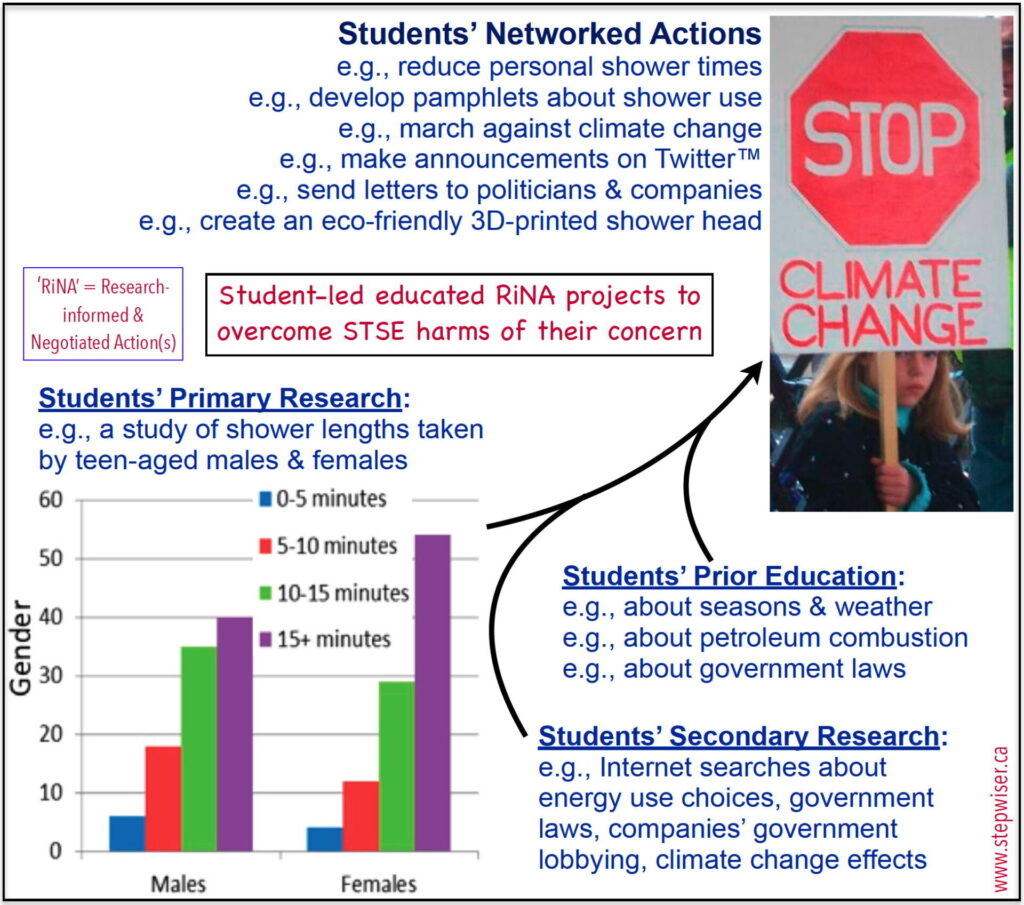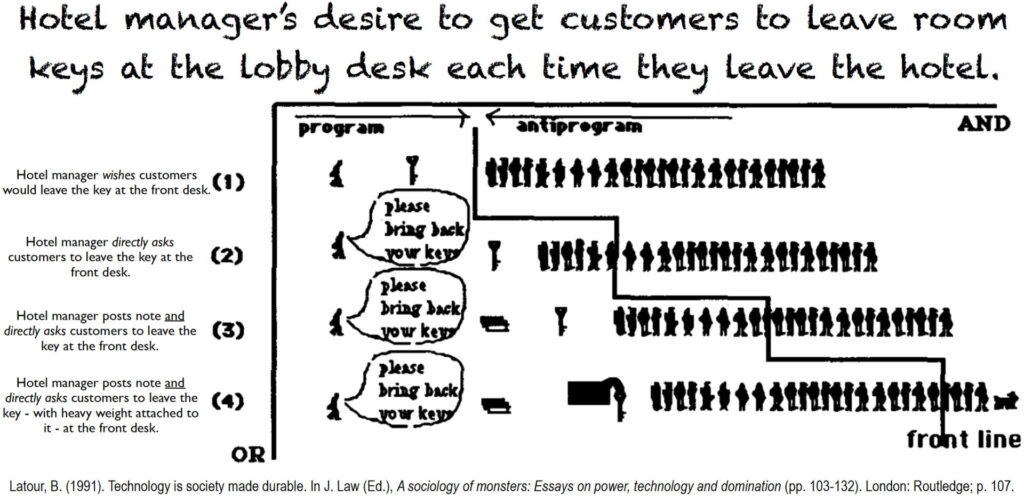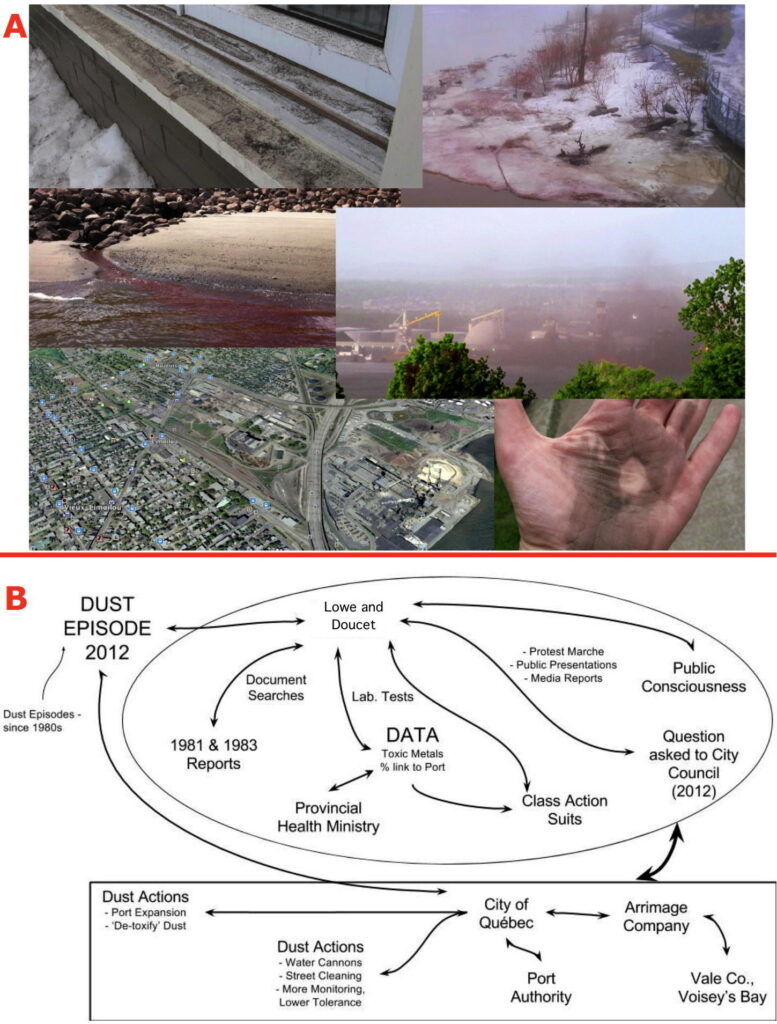Education about STEM-SE Relationships
This page provides perspectives, pedagogical suggestions & resources about relationships among fields of science, technology, engineering & mathematics (STEM) and societies and environments (STEM-SE). As depicted at right/below, such relationships ‘may’ be biased (e.g., politically). Often, educators focus on controversies; e.g., socioscientific issues (SSI). Because controversy can promote doubts and confusion, though, STEPWISE focuses on apparent harms to wellbeing of individuals, societies and/or environments (WISE). With foci on possible harms, students and others may be motivated to develop and implement actions to overcome them – possibly leading to improvements to global social justice and environmental vitality.
Contrary to traditional ‘foundationalist’ & isolationist views of science, STS research (e.g., see STS-Topics) suggests that fields of science are in reciprocal relationships with fields of technology, engineering, mathematics, societies & environments – like here. STEM-SE relationship appear, however, much more complex. Based on actor-network theory (ANT), STEM fields and myriad other living, nonliving & symbolic entities are embedded in dynamic networks as depicted in the animation at right/below. Brief reviews of ANT – here & here – may be helpful.
Pro-capitalist Dispositifs
Although it may seem – as depicted above – that all actants equally co-affect each other, Foucault’s concept of a dispositif suggests that such networks may be biased; i.e., some actants are more influential than others in networks. Among these, there is much evidence and argument suggesting that many or most global networks are dominated by capitalists/capitalism. A particularly influential form of capitalism is neoliberalism, where – as depicted at right/below, for example – capitalist (e.g., financiers & corporations) priorities are promoted by governments and transnational groups (e.g., WTO and Atlas Network) – along with help from different currencies, media organizations and ‘STEM’ fields. Unlike in dictatorships, neoliberalism works to circulate perspectives across networks – leading most people to accept as normal values like possessive individualism and cost externalizations. Such pervasive normalization appears to make capitalism very resilient/resistant to change/replacement.
Also see: Global Economization.
Pro-capitalist STEM Fields
Given reciprocal relationships between S&T/STEM fields and societal zeitgeists (Jasanoff), capitalist influences on the ‘nature’ of such fields are very important. Although there are many exceptions, much evidence suggests that topic choices, research methods, outcomes and sharing of outcomes, etc. often are compromised due to powerful pro-capitalist influences on them (e.g., A; B; C; D; E; F; G). Regarding the schema at right/below, for instance, the Union of Concerned Scientists have suggested that pro-capitalist acts (e.g., manipulated government regulations) can, for example, ‘muzzle’ negative results of scientists’ investigations (e.g., about climate change). Meanwhile, in terms of ‘technology,’ they can prioritize development & marketing of problematic technologies like those involving petroleum. Consequently, pro-capitalist STSE relationships often are associated with numerous STSE Harms like those described below.
Introduction
As discussed above, it seems very important to teach students several cases of apparent personal, social & environmental harms that appear to result from influences of pro-capitalist dispositifs on fields of S&T/STEM and much else. The brief descriptions of such harms below are meant to give educators some ideas in this regard. Most apparent harms are controversial and perhaps exaggerated – like that depicted in the video at right/below. Some general indicators, like at WorldOMeter, may help.
Climate Emergency
As climate activist Greta Thunberg has repeatedly advised (e.g., The Guardian), based on IPCC reports, humanity is facing existential crises – with only about a decade (see CC Clock) to address devastating and irreversible temperature increases. A group of prominent climate scientists also have published dire warnings to humanity about this and there are concerns about possible ‘carbon bombs.’ It appears – e.g., according to Naomi Klein – this emergence is largely due to persistence of pro-capitalist entities’ continuing promotion – especially through government & transnational influences – of petroleum extraction & combustion, while apparently knowing years ago about potential climate disasters (also see here). Some suggestions for actions are provided here. Also see: Climate Investigations Center, which has leaked petroleum company files revealing their knowledge and actions to continue extraction and sales of petroleum (see Petroleum Papers).
Drug Crises
Natural and manufactured drugs, such as ASA (for pain & inflammation) and methotrexate (for cancer), have been very helpful to individuals & societies. As indicated in the video at right, although some drugs (e.g., opioids) have been useful for treating severe pain, aggressive promotion by pharmaceutical companies (among other factors), often with government legal sanctioning, have expanded uses of such drugs so that many people have been harmed or died. Although it may seem obvious to blame drug companies, there are concerns that causes of unhealthy drug uses are more societal – perhaps stimulated largely by capitalist ideologies.
Cigarette Smoking
Cigarette smoking has a long history (e.g., 2000 years ago), often for religious and cultural reasons, but it took a long time before scientists were able to gain strong evidence of its many harmful health effects. The video at right/below and the CDC summary here outline some of the many serious problems. Unfortunately, cancer rates are still increasing and, moreover, are especially problematic in poorer countries. Many people who would like to stop smoking have turned to vaping, but that, too, is not safe (e.g., here). Clearly, because of addictive effects of nicotine in them, it is very difficult to quit cigarette and vaping. Some suggestion for help with this are available, such as here for quitting vaping.
Farming
As described by George Monbiot in the video at right/below, much of our farming practices are extremely harmful to the planet – and, likely, fairness to many individuals (e.g., migrant workers). Although there are numerous technological solutions, as with most so-called ‘techno-fixes,’ they must be made more popular through laws, regulations, etc. of governments and – crucially – transnational groups, like The World Trade Organization. They also need to become accepted by large populations through, for example, media campaigns and public education. To learn more about this issue, you might read books like George Monbiot’s Regenesis. Also see this summary.
Manufactured Foods & Beverages
Among leading causes of sickness & death in many societies are ailments like cancer, cardiovascular diseases & diabetes – and, to a great extent, they are caused by government legal support for companies – with few owning most ‘brands’ – to manufacture unhealthy foods & beverages. In addition to perhaps obvious problems with fast foods, processed foods (often in central rows of supermarkets) often are harmful. At the same time, there is much justifiable concern that people in poorer communities and countries have inadequate access to healthy food (i.e., food security). Analyses of food sources & availability can be found via the Nutrition Action Health Letter. Also see the youth action group, Bite Back.
Electronics Terrorism
Although mainly in technologically ‘developed’ regions (e.g., G20 nations), electronic devices (e.g., computers, cell phones, televisions, etc.) use many minerals mined in poorer regions of the world. Some of these, such as tin, tungston & tantalum, though, are mined in regions where armed militia abuse miners, their families and others to maximize profits. Big companies, like Apple™ & Google™, apparently use such ‘conflict minerals,’ despite knowing about related abuses. Problems like these are tracked and opposed through organizations like Global Witness.
Air Pollution
The air we need to breathe often is not safe! Indeed, according to the World Health Organization, about 7 million people around the world die from air-borne pollutants every year (also see Air Quality Life Index). Much of this comes from burning of fossil fuels which, as you might expect based on comments above, companies – with assistance from government laws – continue to encourage, rather than switching to renewable energy forms. Air pollution is worse, unfortunately, as air temperatures increase – which, again, is tied to government-company supported fossil fuel consumption.
Fast Fashion
Many of us choose to frequently purchase new clothes to maintain our status as part of a dominant, mainstream, group. This can be highly problematic if the clothes are part of a ‘fast fashion’ movement; that is, frequent cycles of purchasing & disposal of relatively inexpensive clothes that are associated with numerous social & environmental costs – such as poor labour conditions, uses of toxic pesticides, deforestation and massive additions to landfills. One of the most basic clothing items in such regards are ‘T-shirts,’ as depicted in the video at right/below.
Plastic Pollution
Petroleum may often be thought of as a fuel and as the major source of climate disruption. But, it also has affected individuals, societies and environments through its conversion into plastics. There are several kinds of plastics that can be made into myriad products that people find very helpful – something that has been promoted for many decades. However, there are numerous harms linked to plastics – largely for those that are not biodegradable. In some – still very ubiquitous – cases, they are or can be degraded into micro-fibres found in common commodities and in myriad organisms’ bodies. But, of course, incredible masses of plastic refuse (e.g., as Nurdles) are routinely deposited in most of our environments – and, infamously, have accumulated in large ocean patches, forming ecosystems called ‘the plastisphere.’ As the video at right/below suggests, though, companies like Coca Cola long ago knew that switching from re-usable glass bottles to plastic ones would be devasating.
Also see: Story of Plastic and Plastic Promises.
Many of us spend much of our spare time being entertained through different forms of popular media (e.g., in television, movies, phone gaming, etc.). These can be informative and stress-reducing. However, to a great extent, many of these represent – as described in the video at right – types of propaganda by powerful individuals (e.g., financiers) and groups (e.g., corporations). Much such manipulation is accomplished by subliminal aspects of media. To a great extent, such manipulation encourages consumerism, but also particular political views. Particularly vulnerable are children, who are increasing targets of powerful advertisers. Teaching resources about misinformation are provided here.
Although products and services generated, in part, by fields of science & technology have been beneficial in many ways, there are growing concerns that living & non-living things are being increasingly connected to form the Internet of Things – which, in turn, appears driven by surveillance capitalism, as stated here. As Dr. Shoshana Zuboff suggests in the video at right, companies mine user data from smart phones, social media, automobiles, fitness tracking devices, (increasingly) living things, etc., etc. to, in a sense, learn about us and engage in behaviour modification processes for profit. Such privacy invasions and manipulation appear, moreover, to be increasing a result of increased online work, etc. due to CoViD-19.
Disaster Capitalism
In putative democracies, with less reliance on military and police, elite and leaders usually need public supports for their perspectives and practices. Such supports can be difficult to obtain, however, in light of citizens’ negative experiences of harms like precarious work, climate disasters and rising food prices. To perhaps distract citizens’ from awareness of or concerns about such harms, though, elite and leaders can – and often have – use(d) public disorientations and fears to further implement neoliberal capitalist policies & practices like: promotion of continuous growth; tax cuts (especially for elite); de-regulation of industries & commerce; reduced social spending (e.g., for health care); disempowering trade unions; and much more. Such disaster capitalism (Klein, 2007) has been known to exploit ‘natural’ (e.g., earthquakes) and ‘anthropogenic’ (e.g., stock market crashes). While it is debatable about the extent to which the CoViD-19 pandemic is a ‘natural’ or ‘human-made’ disaster, it appears to serve as an excellent recent example of disaster capitalism.
During periods in different locations around the world of panic, hardship, worrying, etc., the richest humans accumulated vast proportions of global wealth (Oxfam, 2022) – through, for example, increases in surveillance capitalism (also see: Pandemic Surveillance & Corona Virus Capitalism).
Smart-phone Privacy (& Democracy) Threats
As suggested in the video at right/below, surveillance has massively increased with development of spyware like Pegasus – which can be inserted over networks onto Apple and Android smartphones. Once installed, the software can capture existing information – such as photos and text messages – and turn on apps like audio and video recording to further capture information. Much of the software has been purchased by governments wanting to learn much about opposition – such as from pro-democracy activists – so they can suppress dissent. More about this can be learned about such oppressive spying via an article in here and here.
Animal Testing of Commercial Products
Before many manufactured products, particularly those containing potentially-toxic chemicals, are sold to humans, they may be tested on animals. But, as shown in the video at right, often such testing is very cruel – treating other living things as expendable commodities. Organizations, like PETA & HSI investigate such cruelty and attempt to stop animal testing. However, often companies persist – with profit often their motive.
Crypto Crimes
Most nations use currencies backed by central government regulations and market forces that determine their value. Cryptocurrencies, however, are typically not issued by a central governing authority, instead they rely on multiple networked computers to create a decentralized record system to monitor and anonymously regulate transactions – a distributed ledger. Due to lack of government oversight, cryptocurrencies have been implicated in a number of crimes like pyramid and “pump and dump” schemes that have defrauded speculators millions of dollars. Centralized oversight creates a paper trail when moving large sums of money, the anonymous nature of crypto has made it a facilitator of drug trades, human trafficking and money laundering. Massive environmental costs of cryptocurrencies should not be understated, as the energy costs of producing many of them is ever increasing.
Also see Molly White’s Blog, and an article about her in The Guardian.
For-profit Militarism
We live in a world of increasing authoritarianism – and corresponding decline in liberal democracies. Arguably, such shifts away from more caring and environmentally vital societies seems to be a result of hegemonic influence of neoliberalism since about 1970. Although this is a contentious term/concept, I suggest that it is – simply – facilitated capitalism; e.g., active engagement of governments, transnational groups like the WTO, free-market think tanks, and others, to maximize opportunities for private profit. One such technique – not exclusive to neoliberal states – is militarism. The video at right/below from DoubleDown News, speaks well to this.
Labour Injustices
As emphasized by Karl Marx, in their perpetual search for private profit, capitalists work intensely to minimize their costs. Besides using less expensive – often inferior – materials and more efficient technologies, for example, they have typically worked to reduce labour costs. With help from neoliberal capitalism, job losses (e.g., via offshoring) and, recently, increasing precarity (the ‘gig’ economy) seemed to have greatly increased private profits – at expense of social justice (e.g., poverty). Some suggest this is a new, ‘modern,’ form of slavery – a phenomenon that now is being intensely tracked and about which we can explore regarding our lifestyles.
Long History of Harms
Harms like those above (and many more) are mostly not new. They have persisted for many decades. Severn Suzuki, age 12 in 1992, expressed (in the video at right/below) great frustration about such lack of positive change. Now, about 30 years later, many or most of these problems – like climate disruption, species losses, habitat destruction, myriad forms of pollution, etc. – continue, with no apparent end in sight. It certainly makes you ask why they persist. Her prescient speech seems to carry an important answer: greed. And, as she suggested, (sociopolitical) actions, rather than just words, are necessary.
Sanitizing S&T/STEM Fields Using ‘Trojan Horses’
A major way that pro-capitalist dispositifs influence S&T/STEM fields and many other actants is to sanitize their activities & effects through promotion of cycles of consumption and disposal of commodities that are like Trojan horses (e.g., GE Salmon); that is, projecting positive, perhaps ‘spectacular,’ semiotic (symbolic) messages – leading consumers to enthusiastically & unquestioningly purchase them (often repeatedly). As depicted in the video at right/below, for example, engineered salmon may be ideally depicted in reductionist (punctualized) ways as abundant & ecologically-friendly food supplies, depictions that may distract consumers from awareness of networks involving harmful actants like parasitic sea lice and exclusionary patents.
Also see: The Story of Stuff.
Diversity of Views About the Nature of Science (NoS)
Many people believe that fields of science are highly logical, systematic; e.g., following the ‘scientific method‘ (Losee, 2001) and closely-adhering to Merton’s Norms of ethical practice (e.g., skeptical about one’s own & others’ research). Although Merton was aware scientists often struggled to adhere to his norms, he advised following them – to, for e.g., protect science from outside interference (e.g., from Nazis). This, in turn, contributed to isolationist & ‘foundationalist’ (science –> engineering) conceptions of science like that depicted here & here (Ziman, 1984). Such views have, however, been contested by much STS scholarship. Paul Feyerabend (1975), for instance, concluded that scientists often benefit from not following Merton-like norms of practice. In that vein, Latour & Woolgar (1987) suggested that – as in studies of Mendel’s preferences for theory over data – that scientists’ claims often are socially ‘constructed.’ Similarly, Kuhn (1970) and Lakatos (1970) suggested that scientists often are more influenced by colleagues and dominant theories than by available data. Indeed, there is much STS research to suggest that science often is highly influenced by sociological factors – such as with claims that integrity of many fields of science/STEM are compromised when privately funded (e.g., Ziman, 2000). Given diversity of NoS views like those described at right/below (and here), based on constructivist pedagogy, it seems necessary to first help students to clarify their varied personal positions prior to exposing them to alternatives. In that regard, teachers have had some successes using the NoS Card Exchange Game using statements like these.
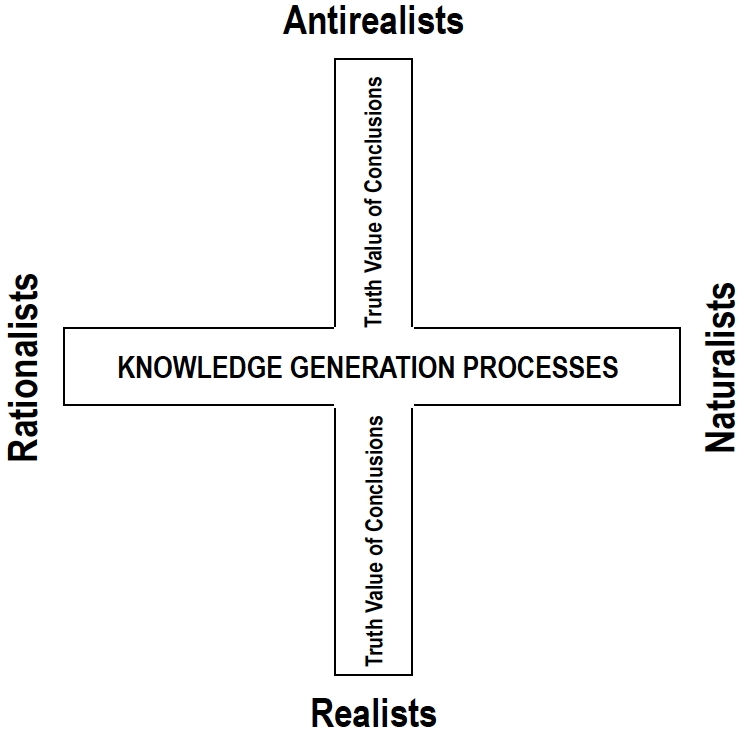
Antirealists - more or less on this spectrum - believe that scientists (& engineers) cannot develop claims (e.g., laws, theories, etc.) that exactly match phenomena of the world.
Rationalists believe - more or less on this spectrum - that scientists' (& engineers') topics & methods (e.g., experiment/study design, measurements, etc.) are highly systematic, logical, unbiased, unemotional, etc.
Realists believe - more or less on this spectrum - that scientists (& engineers) can develop claims (e.g., laws & theories) that match phenomena of the world.
Naturalists believe - more or less on this spectrum - that scientists' (& engineers') topics & methods (e.g., experiment/study design, measurements, etc.) often are, while somewhat systematic & logical, influenced by personal (e.g., emotional) and social (e.g., economic, political, interpersonal, cultural, gender, racial, etc.) factors.
Given diversity of views about NoS, educators may use Loving’s (1991) Scientific Theory Profile shown above (hovering over the four categories provide details) to plan and evaluate lessons & activities (e.g., see here).
Introducing Students to NoS – Focusing on Scientists’ Decisions
In teaching students about different NoS positions, it seems reasonable to start by focusing on internalist decisions (e.g., concluding based on data or theory?) made by scientists. The video at right/below introduces teachers to a set of lessons & student application activities (here) that can, in turn, introduce students to scientists’ – in this case, geneticist Gregor Mendel’s – development of conclusions based on available data and theory. Lessons highlight that Mendel was somewhat selective with available data, erring on the side of his pre-conceived theories about genetic crosses. They also note that such preferences for theories over available data are common and, indeed, seem to have benefited science progress. To supplement these lessons & activities, teachers may also use lessons & activities about: i) the Scientific Theory Profile; and, ii) Internal vs. External Factors Affecting Science.
Teaching About Power via Actor-Network Theory
Much about STSE relationships can be taught in terms of actor-network theory (ANT), an ontological conception assuming that all natural & engineered living, nonliving & symbolic (semiotic) entities (actants) are reciprocally integrated into a vast network. Particularly important are dispositifs; i.e., groups of actants that generally co-support common causes. Of great concern are pro-capitalist dispositifs, with cooperation among actants – as illustrated here – like: corporations, STEM fields, banks, currencies, etc. Often, such dispositifs are punctualized; i.e., made to appear less complex (even ‘singular’). Like a Trojan horse, objects – such as genetically-engineered salmon, personal care products & cell phones in the video at right – can appear positive on the ‘surface,’ often in normalized ways, which can distract consumers from awareness of problematic network connections.
Our Multi-Actant Commodity Arrays and Multi-Actant Documentaries can help introduce students to ANT, dispositifs & punctualization.
To deepen students’ analyses of ST[EM]SE relationships, research and social actions to overcome harms in STSE relationships, we provide, through the videos at right, suggestions & resources for teaching – with applications – students to use actor-network mapping.
Resources: ANT Overview; ANT Summary; ANT Introduction.
Some sample ANT-based lessons are described here. The first 4 videos highlight teaching of ANT in an ‘academic’ (university-qualifying) 10th grade science course, followed by a discussion with students about this work.
Part D is currently unavailable.
PROSUMPTION (Credit: Majd Zouda & Team)
A major pro-capitalist mechanism is prosumption; that is, ‘production’ associated with consumption of for-profit items. The video at below provides teachers with an overview of this concept. Teachers may or may not choose to show it to students. This video is accompanied by a 1-page summary of prosumption, here. The sets of videos below are meant to teach students about prosumption – through Input, followed by student Application, in two cases.
Prosumption Lessons & Activities
REGULATORY CAPTURE (Credit: Sarah El Halwany & Team)
A key aspect of neoliberal capitalism is for governments (and transnational entities, like the WTO) to set laws, regulations, etc. to benefit private sector entities (e.g., financiers & corporations) – often harming individuals, societies and/or environments. When governing agencies (e.g., FDA) that are meant to regulate – or minimize harmful effects of – businesses instead rule in their favour, they are said to be captured. Such regulatory capture can contribute to many STSE Harms. After reviewing the video about this below, along with this summary, teachers may then use video-based resources at right/below to help students to develop useful conceptions of regulatory capture that they may use in their RiNA projects.
See article, Science, The Endless Frontier of Regulatory Capture.
Teacher Input
The two videos at below can introduce students to attitudes, skills & knowledge regarding government regulation of businesses and phenomena relating to regulatory capture. See also the Descriptions below each video.
Student Application Activity
To deepen students’ understanding of regulatory capture, they can complete activities in the video below, including info. in the Description below.
SOCIOTECHNICAL IMAGINARIES (Credit: Sarah El Halwany & Team)
As discussed in the video below, we often take for granted certain thoughts & actions – like assuming it is OK for many people to communicate via ‘smart’ phones. Reasons for this are complex, but a popular idea is that living & non-living things – including people & technologies – are connected to each other, linked by common values like: being independent; always seeking something new; not worrying about less fortunate people. These connections among things & values, etc. are called sociotechnical imaginaries – because they limit and/or enable what we can imagine for now and for future living.
Technologies & Their Hidden Values
One way to teach about sociotechnical imaginaries is to talk about how technology (here, the brain training program, Lumosity) prescribes particular visions of the productive citizen &/or employer and ideas of ‘wellbeing’. Students, then, get to apply what they have learned using the example of self-tracking devices and the quantified self movement.
Emotive Actants & Sociotechnical Imaginaries
Another way to teach about sociotechnical imaginaries is to address how emotions (as ‘actants’) can be manipulated and managed to support particular visions (e.g. fear from other things) through, for instance, surveillance applications and cosmetics. Students can then apply what they have learned using the example of emotional technology that champion particular visions of economic productivity, intimacy, self-knowledge that reproduce White, middle-class, priorities and neoliberalism.
Facial Recognition Critique; Detention Camps Critique; Israel-Palestine Tensions; Surveillance Capitalism; Emotional Technology.
Future Visions & Sociotechnical Imaginaries
A third way to teach about sociotechnical imaginaries is to get students to think about preferred & desirable futures by asking whose future matters. This is addressed in the case of ‘modern’ agriculture in India and related social & environmental problems linked to ‘miracle’ seeds and chemicals. Students can then apply their learning using the example of palm oil production, how it supports some futures at the expense of other futures (e.g. those of dispossessed and Indigenous communities). They could, then, use concepts about sociotechnicical imaginaries to plan alternative arrangements of actions (dispositifs) that mutually promote students’ ideals.
‘ASTROTURFING’ (Credit: Majd Zouda & Team)
Many of our personal, social & environmental problems appear largely due to egotistic influences of powerful people & groups on fields of science & technology. In this series of videos, as described in the introductory video below, teachers are provided with suggestions for teaching about general difficulties that scientists may have in achieving ‘truths’ about phenomena and then how private sector interests – often with government supports – can manipulate fields of science & technology and also stimulate ‘astroturfing’; i.e., development of fake ‘grassroots’ activist groups.
Introduction
Given persistence of harms linked to pro-capitalist dispositifs, citizens need to become – e.g., through science & technology education – more personally and sociopolitically active to increase global social justice & environmental vitality. Such actions may vary, depending – for example – on people’s different talents & interests. As illustrated below, many actions may be considered propositional (e.g., developing Signs to promote certain changes in the World). Others, like engineering designs, may, though, be actualizable – directly changing the World.

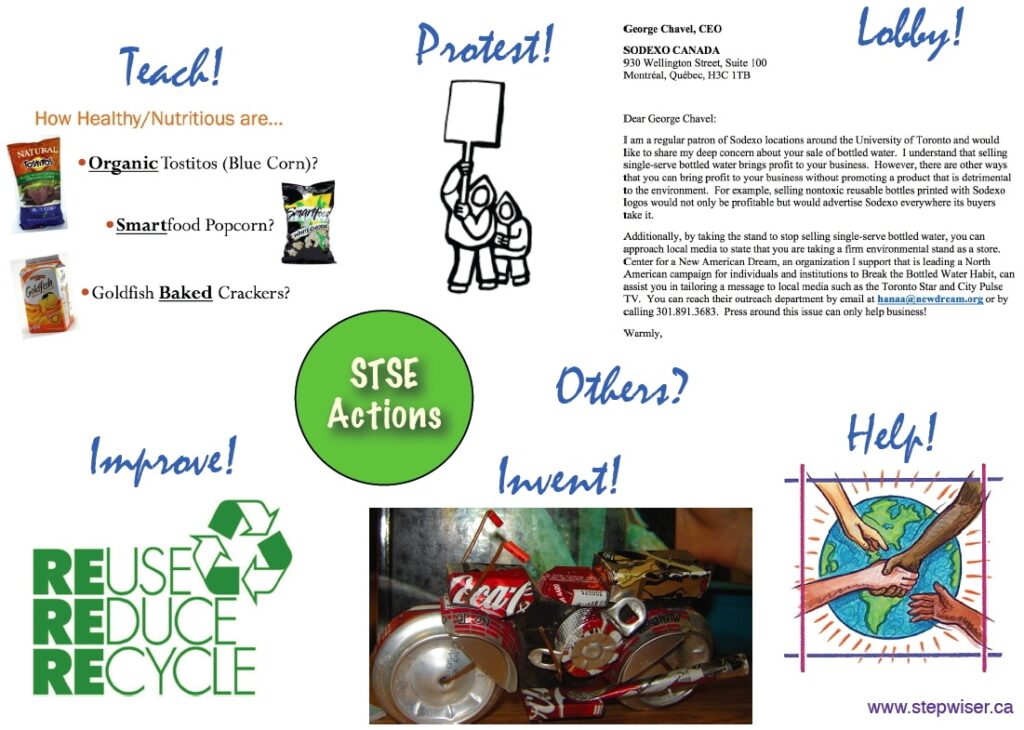
STS-based Teaching Regarding Engineering Design
Enabling ‘WISE’ Technology Design & Mobilization
Although STEM education initiatives vary, many appear to prioritize education about numerous engineering products & services, as well as education to help students engage in engineering design processes. Given frequent STEM education emphases on educating students to help with global economic competitions (e.g., in TDSB), it seems clear engineering foci may primarily benefit capitalists. Indeed, as discussed variously on this website, neoliberalism seems to largely have influenced STEM fields to prioritize profit over broader wellbeing – which appear linked to many STSE Harms, many of which involve apparently-problematic technologies. Accordingly, we have been promoting ‘WISE’ technology designs by students – as illustrated & explained at right/below.
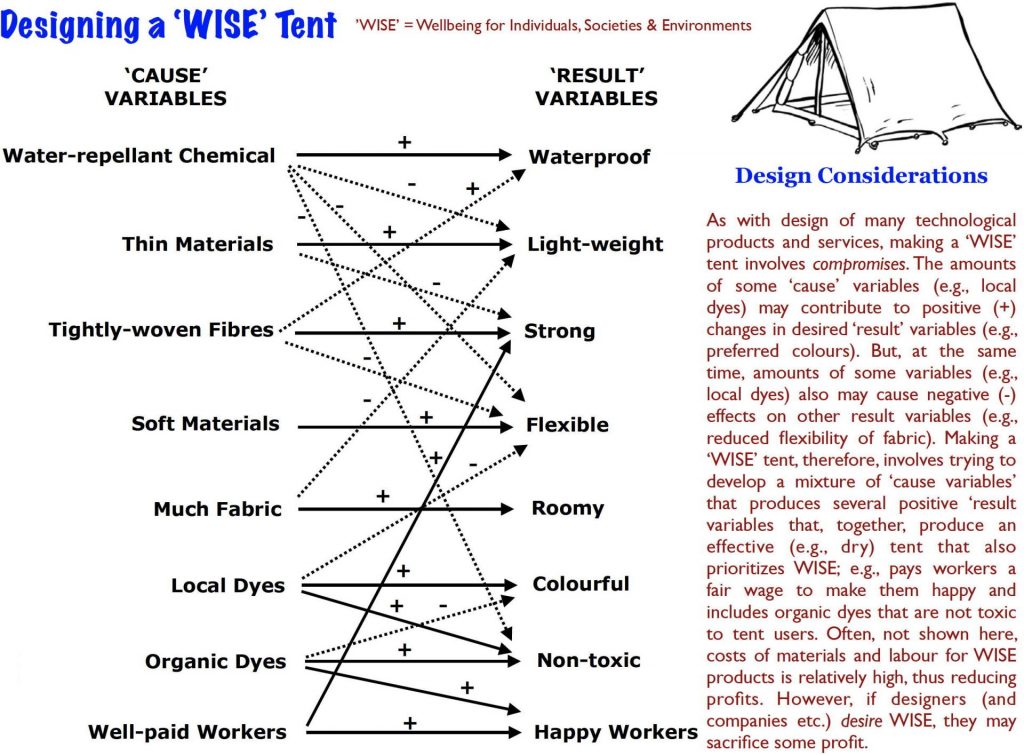
Promoting ANT Analyses for WISE Tech Design & Mobilization
Given that actor-network theory (ANT) can explain our world, we suggest that students’ WISE technology designs can be aided by teaching them to analyze existing technologies as ANT maps and then re-vision tech designs to align with their values (e.g., more ecojust colognes). Such teaching has helped students create other ecojust innovations like those at righ/below.
Although students’ new technologies may promote increased WISE, students’ values as expressed in them can be spread (mobilized) if, as a high school teacher explains in the video below, they are taught about and encouraged to use concepts of sociotechnical imaginaries.
Students Imagining Supportive Networks for Their Ecojust Innovations
After students had been taught about several concepts from STS, including actor-network theory, dispositifs, semiotics and sociotechnical imaginaries, they were able to envisage networks of actants to support their new, ecojust, innovations in contrast to existing dispositifs. In the figure at right/below, a student illustrates a network in support of her more socially just and ecologically sustainable chicken incubator. While such ecojust engineering products can be helpful, their effectiveness depends on distributions of values inherent to them across networks (dispositifs) of living, non-living & symbolic actants.
The Nature of RiNA Projects
As illustrated in the image at right/below, RiNA (research-informed & negotiated action) projects are efforts to engage in sociopolitical actions that are meant to help overcome harms – like the climate crisis – in STSE relationships that governments and others often have struggled to effectively address. Often, ‘harms’ are controversial (as ‘STSE Issues’) – for many reasons, not the least of which are people’s political orientations/value systems (e.g., Political Compass) – and, so, directions for and kinds of actions are best settled through ‘secondary’ & ‘primary’ research and some social negotiation. Also, people who have some relevant prior education – e.g., about science & technology knowledge, STSE issues, research & actions, etc. from the 3-phase STEPWISE pedagogy – often have most successes with their projects. At the same time, students are most motivated to develop and implement RiNA projects when they address harms/issues of their concern and talents. It is extremely important that students are encouraged and enabled to conduct RiNA projects of their own design because of severity and persistence of so many STSE harms.
The schema at right/below is one way of understanding RiNA projects. It was initially used by Roth (2001) to depict relationships between ‘science’ & ‘technology’ (engineering); but, assuming mathematics often is involved throughout, it could also depict STEM fields. The model suggests that students’ RiNA projects can, generally, focus on World –> Sign and Sign –> World translations. Among many variations, students’ actions may be either or both suggestions (e.g., via posters) for changes in the World &/or more direct changes (e.g., new technologies) in the World.

Ontological Gaps (mis-translations) occur because of differences in composition of World (e.g., tree) & Signs (e.g., drawing of tree); Ideological Gaps are intentional mis-translations; e.g., climate change deniers narrowly depict global temperature changes.
Needs to Assemble Dispositifs
For RiNA projects to be effective, their actions often need to form one or more dispositifs; i.e., networks of co-supportive living, nonliving & symbolic ‘actants.’As illustrated below, Latour explained that a hotel manager was able to convince more guests to leave their keys at the front desk by adding supportive actants.
For example, as illustrated at right/below, citizens of Québec City who were alarmed by excessive dust deposits (especially in 2012 [A]) had some successes from supports from actants like: data they collected & had analyzed; earlier dust deposit reports; activists’ website; general public consciousness; class action suits; etc. At the same time, activist dispositifs often are challenged by dispositifs supporting alternative, often dominant, perspectives – such as supporters of continuing and, often, increasing storing of nickel ore in open piles at the city port. In other words, STSE issues often involve competing dispositifs (B), each a set of actants aligned to support different values, principles, actions, etc.
